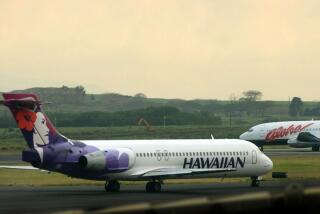Legislators Arriving in Bahrain for Gulf Inquiry
- Share via
MANAMA, Bahrain — Congressional delegation members began arriving Saturday in Bahrain to assess security for U.S. ships in the Persian Gulf as cleanup crews worked aboard the crippled U.S. Navy frigate Stark.
The crews were clearing twisted metal from the frigate’s wrecked electronic control center and placing the debris in dumpsters, according to a source close to a Navy investigation of the May 17 incident, in which Iraqi missiles struck the Stark, killing 37 crewmen.
The source, who asked not to be named, spoke in Bahrain after visiting the frigate off the coast.
Sen. Sasser Arrives
Sen. Jim Sasser (D-Tenn.) arrived here Saturday to lead a fact-finding delegation. He said he plans to board the Stark today and talk to its crew and Navy investigators.
Sens. John W. Warner (R-Va.), and John Glenn (D-Ohio), the former astronaut, plan to tour the Persian Gulf region later this week. Warner was secretary of the Navy from 1972 to 1974.
Senate Majority Leader Robert C. Byrd (D-W.Va.), who announced the Senate delegation, said it will “assess the situation on the Stark, threats to American forces and vessels in the region, and threats to Kuwaiti interests and shipping.”
All three delegation members have said they are concerned about the risks involved in a U.S. plan to escort Kuwaiti oil tankers in the northern Persian Gulf area, one of the major arenas of the 6 1/2-year-old Iran-Iraq War.
Rep. Les Aspin (D-Wis.), chairman of the House Armed Services Committee, said he was also sending a delegation to the region, but details were not immediately available.
Damage Details Given
The source close to the Navy investigation provided a detailed description Saturday of damage to the Stark. He said the first missile, a water-skimming Exocet, punched a hole but failed to detonate. A second missile, still unidentified by type, exploded and touched off an inferno.
The source said the first missile entered the vessel near the overhead, or ceiling, of one deck. It tore a gaping tunnel through the port side, then hit the inside of the starboard hull, punching a small hole there.
The second missile barreled down into a small, confined area, where it exploded, causing tremendous damage because the space was limited, the source said.
It exploded “upward and outward” next to some of the crew’s quarters and sparked a fierce blaze made worse by the presence nearby of chemical-filled piping, the source said. The entry point of the second missile has not been determined.
The source said the crew’s quarters and the electronic control room are now a mass of tangled steel and dangling cables.
More to Read
Sign up for Essential California
The most important California stories and recommendations in your inbox every morning.
You may occasionally receive promotional content from the Los Angeles Times.









